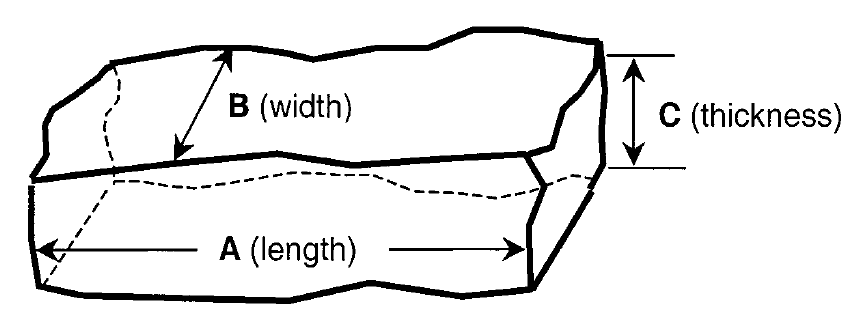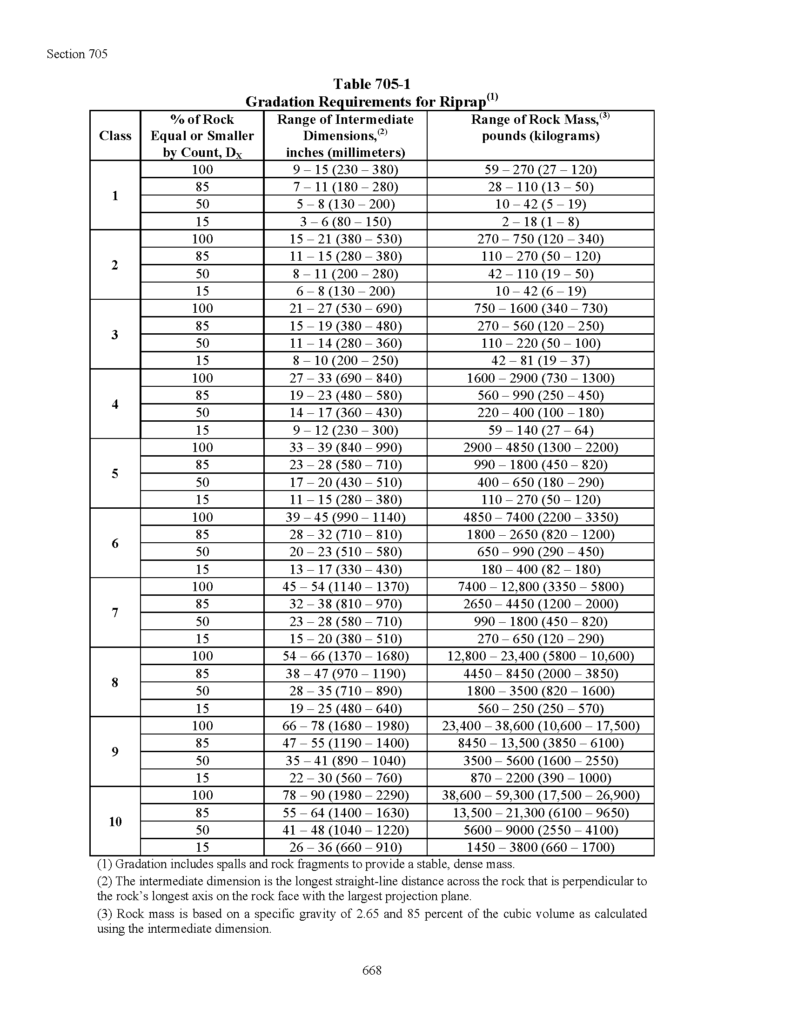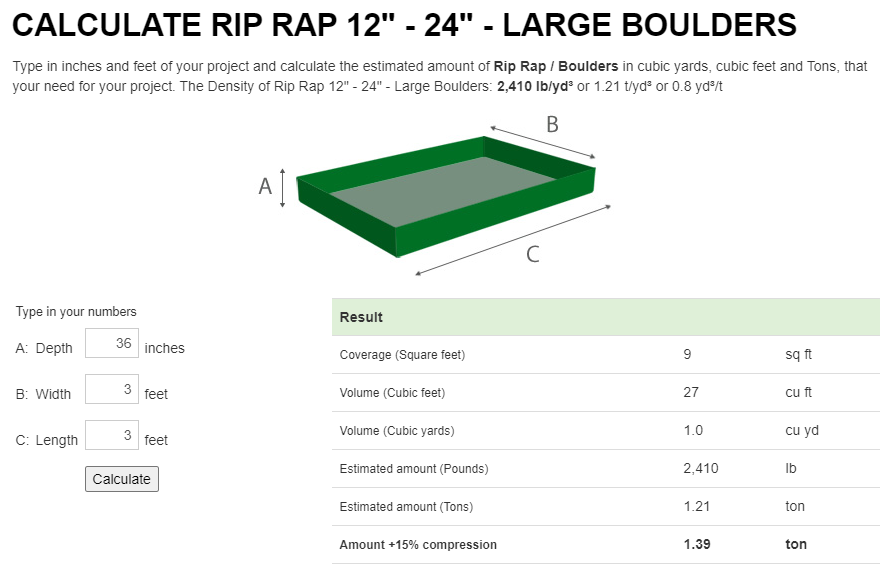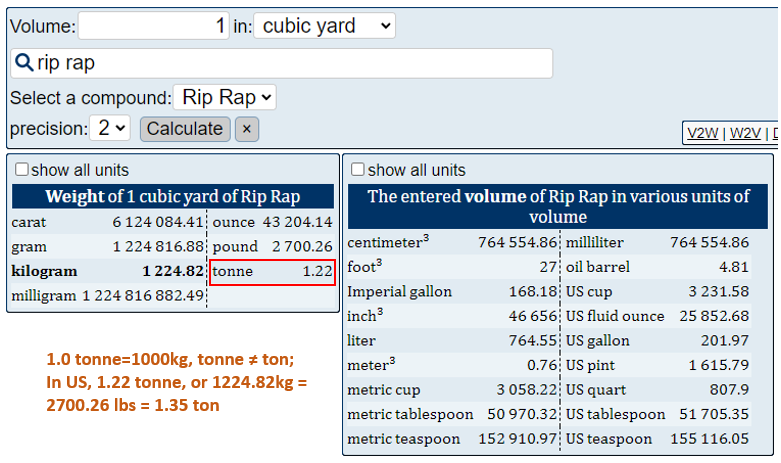Riprap Density, Porosity, Volume, and Weight
Riprap is widely used and considered as a desirable type of revetment in the United States. It consists of a layer of natural or man-made rock/stone placed on bedding and/or filter layer (Note: bedding layer is different from filter layer) to dissipate water energy and protect channel banks, bridge piers and abutments, or shorelines from erosion caused by the action of flows, currents, or waves.
The riprap needs to be big enough to ensure it critical shear stress is greater than the shear stress imposed on it by flowing water; otherwise, the riprap will be displaced by water movement. In engineering practice, it is often convenient to use the concept of critical velocity in lieu of critical shear stress by designing a riprap whose critical velocity is greater than design velocity.
To successfully design riprap protection, usually the following steps are to be followed:
- Calculate a characteristic size of riprap, usually D50 (or D30) diameter, according to the theory of critical shear stress or velocity.
- Based on D50 (or other characteristic size), select appropriate riprap gradations. Riprap needs to be well graded to provide interlocking between riprap stones.
- Design riprap layer thickness, heights, slopes, limits, and toes.
- If needed, design the required filter layer (granular filter or geotextile filer fabric) under riprap.
- If required, add a bedding layer in between riprap and geotextile filter to prevent big-sized riprap from damaging the geotextile fabric underneath.
- Work on specifications of riprap installation, including material sources, placement methods, durability testing, measurement and payment.
Isbash Equation is often used for preliminary estimation of a required riprap size (D50) under a design velocity (Figure 1). For final design of river bank revetment, bridge scour countermeasures, and culvert outlet protection, more suitable equations are provided by FHWA HEC-23 Volume 2 and HEC-14.

The riprap particle density, aka solid component density or mineral density, varies from different regulation agencies, but usually these values are consistent. Quite often in engineering practice, specific gravity – SG is used in lieu of particle density, where SG = particle density/water density=particle density/62.4 lb/ft^3.
- FHWA: HEC-11, HEC-15, HEC-23, and HDS-6 use 2.65 for riprap specific gravity or a density of 2.65 x 62.4=165 lb/ft^3.
- NRCS: National Engineering Book Part 654 Technical Supplement 14C – Stone Sizing Criteria describes a wide range of riprap density from 135 to 205 lb/ft^3.
- USACE: EM 1110-2-1601 states that the density of riprap generally varies from 150 to 175 lb/ft^3
- TxDOT: TxDOT standard specification book of 2014 Item 432 uses specific gravity of 2.5 for riprap, which is equal to a density of 2.5 x 62.4=156 lb/ft^3
The angle of repose of riprap is normally 40° according to USACE EM 1110-2-1601, as opposed to 30° to 44° for cohesionless soil material in air per FHWA HEC-18.
The shape of a riprap stone can be described by designating three axes of measurement: major – A, intermediate – B, and minor – C, as shown in Figure 2. Riprap stones should not be thin and platy, or long and spiky. Usually it is required that A/C is no greater than (=<) 3.0 for a suitable riprap stone shape.

To calculate a riprap stone’s weight from its volume, FHWA HEC-23 and TxDOT standard specification book of 2014 assume the volume of a riprap stone is 85% of a cube with the same characteristic size D (HEC-23 interprets D as the intermediate – B) (Figure 3).

USACE EM 1110-2-1601 considers riprap as spherical shape and thus the relationship of a riprap stone diameter and weight is as shown in Figure 4.

FHWA has a standard riprap class gradations as shown in Figure 5.

Riprap is paid for by volume in cubic yard or by weight in ton (1.0ton=2,000lbs) in the United States. To convert riprap layer in volume to weight, a riprap bulk density (in-place density) value is required.
The riprap bulk density is measured at its placement status with the volume including the voids in between riprap stones (porosity). The bulk density should not be confused with the riprap particle density discussed above which does not include voids: Bulk Density = (1 – Porosity) * Particle Density.
The values of riprap bulk density varies greatly from difference sources due to different installation methods, compression, and porosity. To do a ballpark estimate on riprap bulk density, let’s assume the porosity (V-void/V-total, where V-total = V-void+V-solid) is 20% to 40% and the riprap specific weight is 2.5, and its bulk density is equal to (1-Porosity) * 2.5 * 62.4 lb/ft^3 = 93.6 ~124.8 lb/ft^3, or (1.26 ~ 1.68 ton/yd^3), which is consistent with the values from other sources summarized below.
- FHWA HEC-15 states that the placed density of uniformly graded gravel is 1.5 ton/yd^3 (or 111.11 lb/ft^3)
- NRCS National Engineering Handbook Part 642, MN Construction Specification states that rock riprap weighs 1.2 to 1.7 tons per cubic yard (or 88.89 to 125.93 lb/ft^3)
- Gravelshop.com states that the density of Rip Rap 12″ – 24″ – Large Boulders is 2,410 lb/yd³ or 1.21 ton/yd^3 (or 89.63 lb/ft^3)(Figure 6)

- https://www.aqua-calc.com/calculate/volume-to-weight uses 1.35 ton/yd^3 (or 100.00 lb/ft^3) to calculate weight from volume (Figure 7). It is worth noting that the unit of tonne is different from ton and 1.22 tonne is approximately equal to 1.35 ton.

1 COMMENT